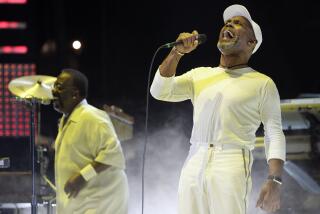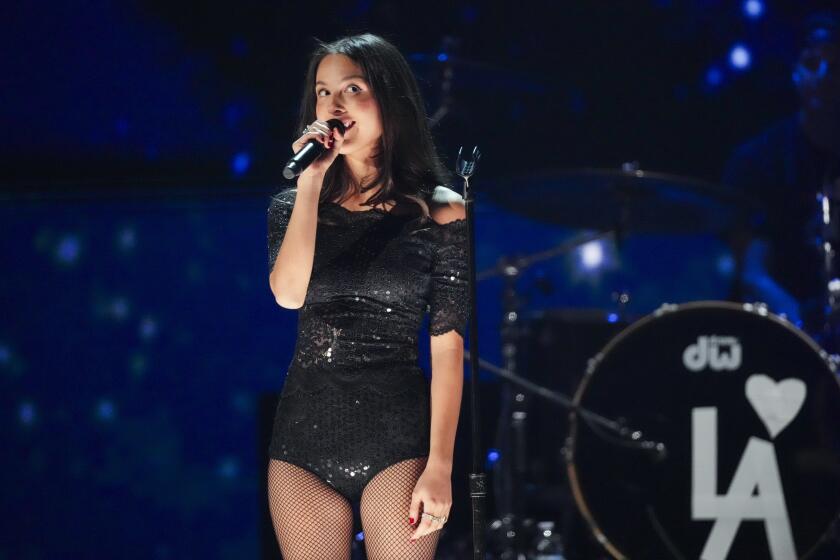COMMENTARY : REGGAE--CAN THE BEAT GO ON?
- Share via
The death of Peter Tosh, gunned down Sept. 11 at his Kingston, Jamaica, home during an apparent robbery, is only the latest tragedy in the reggae world.
Tosh’s murder follows by a few months the ambush slaying of Wailers’ drummer Carleton Barrett, allegedly shot by his wife’s lover. But reggae’s current problems extend beyond these terrible personal losses: In many respects, the legacy of the first wave of Jamaican artists who brought reggae to the pop world is being eroded.
In a recent article “Reggae in Crisis” for Reggae Beat magazine, San Francisco advocate Doug Wendt complained of artists who “make a mockery of Bob Marley and his advancements, crumbling the steps he built into sand.” Wendt concluded the article by writing, “After so much progress, reggae’s major barrier, it turns out, is itself.”
Contributing factors include resistance from American radio that has forced artists to dilute reggae’s distinctiveness to court crossover airplay or be shunted off to the cult audience and specialty labels like Shanachie, Heartbeat or RAS. The media’s fixation on searching for the next Bob Marley hasn’t helped new artists develop a following.
But the second generation of reggae artists hasn’t created music anywhere near as compelling as their predecessors did. Then there are those notorious Jamaican music business practices--take the disheartening situation with the late Bob Marley’s estate.
Marley, of course, merely put Jamaican music on the international music map, defined reggae’s sound and look, wrote the lion’s share of its most enduring songs and was one of the most commanding stage performers pop music has ever known. The only place that hadn’t fully embraced Marley as a giant when he died of cancer in 1981 was the United States.
Marley set up his Tuff Gong business empire to protect himself and the Wailers from the “Babylon” legal/business system that had exploited him and other reggae musicians in the past. But he didn’t believe in written contracts and now the Tuff Gong studio has been sold, the Wailers band are estranged from the estate, and the projected museum celebrating Marley’s accomplishments may never become a reality.
Peter Tosh’s career embodied many of the problems reggae has encountered in entering the international pop mainstream.
The singer/guitarist formed the Wailers with Marley, Bunny (Wailer) Livingston, Junior Braithwaite and Beverly Kelso as a vocal harmony group inspired by American soul groups like the Impressions. A string of hit singles through 1966 made the Wailers Jamaican heroes, but the group weathered a rough period until they joined forces with producer Lee Perry.
Those 1969 and 1970 sessions restored the Wailers to prominence and united the Marley-Tosh-Livingston triumvirate with the nonpareil rhythm section of bassist Aston (Family Man) Barrett and Carleton Barrett. The new line-up signed to Island Records and, starting with its 1973 album “Catch a Fire,” essentially defined reggae as the music world knows it today.
Tosh contributed “400 Years,” the anthemic “Get Up, Stand Up” and “Stop That Train” to the Wailer’s early repertoire but left the band in 1974. His solo career got off to a strong start with the politically militant and musically muscular “Legalize It” and “Equal Rights” albums but his later records were marred by spotty songwriting and flirtations with disco and rock.
Even though he was championed by rock demigods the Rolling Stones, Tosh never matched Marley’s stature. He continued to be a strong concert attraction, selling out the Greek Theater in his last local appearance in August, 1984. “No Nuclear War” was his first album in four years.
Though his death is being mourned throughout the reggae community, he wasn’t the innovative force he used to be. But the fading fortunes of the old guard is only one of reggae’s current difficulties.
One fundamental problem is the style’s dual nature. The music of Marley and Tosh defined reggae to the pop world as a provocative lyrical mixture of spiritual force and social commentary tied to an irresistibly sexy rhythmic pulse.
But reggae is just danceable Jamaican pop music, too, and reggae artists in the ‘80s have leaned heavily in that direction. Neither the “dance hall” sound nor the deejay “toasters” (the Jamaican equivalent of rappers) have captured the public imagination outside of the committed reggae audience.
Another factor is the cyclical phenomenon that affects virtually every local and/or regional scene, from southern soul in the ‘60s to punk in the ‘80s. Initially, a small circle of musicians create a new style from scratch and feed off the scene as a whole. With success comes broadened horizons, divergent interests and individual career demands that progressively chip away at that common identification.
So reggae performers began incorporating elements of rock and different aspects of black American music they found appealing--just as artists like the Police, Culture Club and Tina Turner used reggae rhythms in some of their biggest hits. Radio always preferred those (often valid) interpretations of reggae to the real thing by black Jamaican artists. And media interest has gradually waned following the death of Marley; reggae was an exotic new world 10 years ago, but it’s old hat now.
That situation has prompted many reggae performers to search for that potentially lucrative crossover sound or run the risk of being left out in the cold. Judy Mowatt, a gifted singer/producer/songwriter operating at the peak of her creative power, may never get a richly deserved shot at the mainstream pop/R&B; audience because she will be stigmatized as a reggae cult artist rather than a great artist whose musical base happens to be reggae.
But some of reggae’s problems are self-inflicted. Marley’s success brought hundreds of new performers and producers into reggae with visions of stardom and big bucks dancing in their heads. An ongoing lack of professionalism in reggae business practices has started to wear down the style’s most ardent advocates outside of Jamaica.
Locally, Roger Steffens stepped down from KCRW-FM’s acclaimed “Reggae Beat” program after eight years, in part because of the strain of dealing with those problems. Wendt’s article is a scathing attack on the lack of realistic business sense among reggae performers, agents and promoters.
That isn’t to suggest that there isn’t any vital music being made by reggae performers now, or that every concert involving reggae artists is suspect. Reggae is a permanent part of the pop music landscape, but it has a history and a defined style now--artists like Marley and Tosh were inventing it as they went along.
That suggests that the next phase for reggae will be a shakedown process where a new crop of artists starts focusing in on the elements that make reggae unique from the myriad of styles currently cluttering up Jamaican music. Reggae has one vital ace in the hole--the steadfast loyalty of its fans. But the style needs to be revitalized to claim the prominent position in the pop world many observers once envisioned for it.
More to Read
The biggest entertainment stories
Get our big stories about Hollywood, film, television, music, arts, culture and more right in your inbox as soon as they publish.
You may occasionally receive promotional content from the Los Angeles Times.










